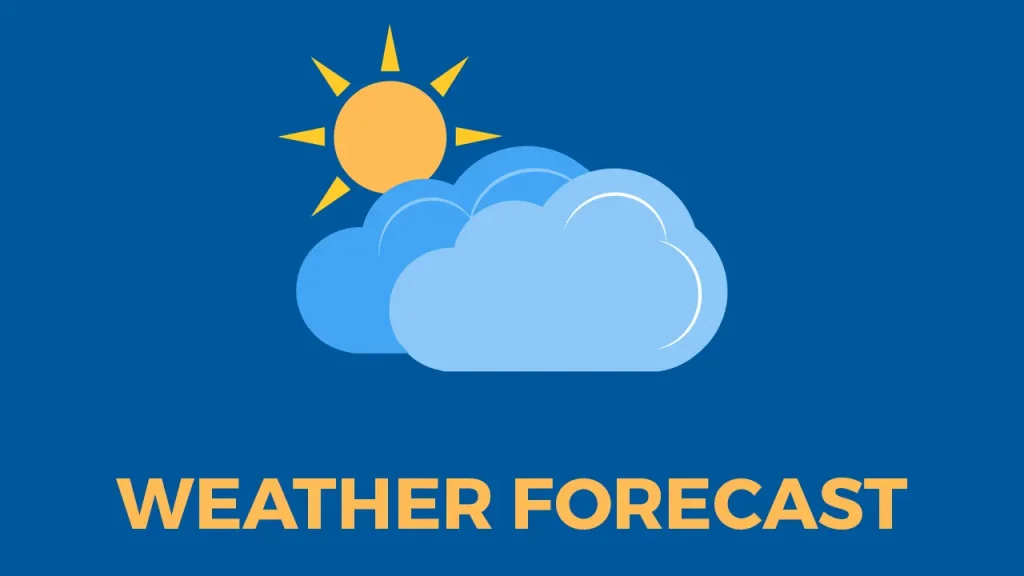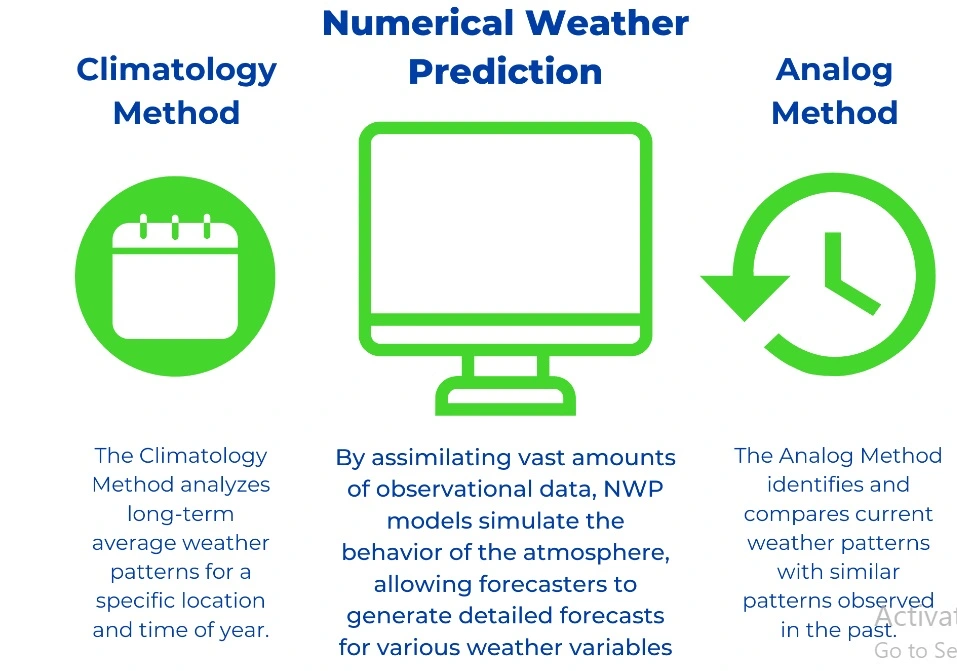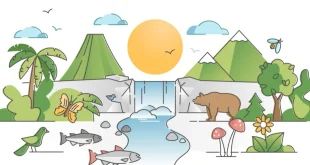
What is the Weather Forecasting?
Weather forecasting is the practice of science and technology to forecast atmospheric conditions for a specific place and period. For centuries, people have tried to forecast the weather casually, and official forecasting started in the 19th century.
Weather forecasting, which used to be done by hand and was focused mostly on disparities in barometric pressure, sky state, existing weather patterns, and cloud cover, is now done using computer-based models that explain a variety of atmospheric variables.
Weather predictions are created by collecting objective data about the actual situation of the atmosphere at a certain site and using meteorology to predict how the weather will perform in the future. Human response is also required to choose the best conceivable forecast model on which to base the forecast.
Importance of Weather Forecasting
Human dependence on weather and climate has led him to take on a systematic study of the various components of weather. This involves intense observation, precise recording, and correct processing of the elements of climate such as temperature, rainfall, humidity, winds, air pressure, clouds, etc.
There are several uses of weather forecasting in day-to-day life, it can be as simple as choosing your outfit or deciding whether to take an umbrella with you on your work.
Key areas where weather forecasting plays a main role
- Nature and seasons play a key role in farming and agriculture. When it comes to the farming of various vegetables, fruits, and pulses, temperature is tremendously important. Farmers didn’t understand better the weather forecasts before, so they had to depend on estimates to do their jobs.
They do, however, sometimes suffer as a result of imprecise weather forecasts. Now farmers get all of the weather forecasts on their smartphones, thanks to advancements in technology and the use of exclusive weather forecasting mechanisms. Of course, education in this area is crucial, but the majority of the farmer community at this point understands the basics, making it simple for them to use the features.
- Weather forecasting helps the transportation of food grain and storage.
- It helps in the handling of cultural operations such as weeding, harrowing, etc.
- It aids in the application of livestock protection initiatives.
- Weather Forecasting is critical since it helps to control future climate changes. With the use of latitude, we can determine the possibility of hail and snow reaching the surface. We can identify the heat energy from the sun that is exposed to a region.
Climatology vs meteorology
Climatology is the scientific study of climate, which in simple words means weather conditions over a long period. A lot of studies within atmospheric sciences also take the help of the averages and variables of short and long-term weather conditions gathered.
Climatology and meteorology are different from each other and can be divided into further areas of study.
A weather forecast is released by the meteorological department of a country based on information collected by using various satellite images as well as instruments.
Meteorological stations or weather stations are the places where weather circumstances are studied using different instruments. These stations are located all over the world, including the oceans where weather ships collect a wide range of data for assuming weather predictions.
Weather satellites encompassing the earth provide useful statistics through storms, pictures of clouds, and other weather phenomena. All this supports the meteorologists to forecast the weather fairly precisely.
Types of Weather Forecasting
There are three types of weather forecasting such as;
Short Range Forecasting
This forecasting lasts 1-2 days. The weather has a huge influence on human daily patterns, personal comfort zones, and the production of food. Weather forecasting plays a significant role in planning current and future activities. So, other aspects may have a huge impact on the forecasting outcome.
However, precise forecasting is very crucial. Forecasting is an important method for various analyses. European Centre for Medium-Range Weather Forecasts (ECMWF) is the most precise global model. ECMWF performs way better than the Global Forecast System (GFS).
Medium Range Forecasting
This type of weather forecasting lasts 3-4 days to 2 weeks. These forecasts are made for small strategic resolutions in association with the nature of the business. They are very significant in the area of business budgeting and development and it is from this forecast that companies decide their budgets.
Imprecise forecasting can have serious effects on the rest of the organization as it will be forced to be with the unsold stock and have to overspend on production again. A huge amount of money has to be paid to creditors and banks, and stock may have to be sold at a very low price. Organizations can break or bankrupt due to insufficient attention to medium-term sales forecasting. The period for a medium-term forecast is usually one year.
Long-Range Forecasts
This forecasting is for times longer than a month. Long-term forecasts are for mostly major upcoming strategic decisions to be taken for the organization and within an organization. They agree with basic items rather than specific items and therefore, organizations are concerned more with overall ongoing trends. By following these trends, regular efforts to predict revenue-generating sales over periods larger than two years.
Methods Used in Weather Forecasting

Synoptic Method
A methodical study of recent weather forecasts from an extensive area is used in this method of weather forecasting. Present weather conditions are connected to comparable scenarios in the past, and predictions are based on evidence that the current scenario would behave similarly to a similar situation in the past.
Statistical Method
Between different weather elements, regression equations or other progressive relationships and the subsequent climate are formed. Weather criteria or predictions are typically chosen based on a possible physical interaction with the predictions.
Numerical Weather Prediction Method
Its definition states that it forecasts weather by using statistical models of the atmosphere and oceans reliant on current weather conditions. The action of the atmosphere is articulated in this system by a series of equations based on air pressure, physical laws governing airflow, and other data. The method is optimal for medium-term forecasts.
Weather Forecasting Process
A weather forecast is complete up of three steps such as observation and analysis, extrapolation to regulate the state of the atmosphere in the future, and estimation of precise variables. One method of qualitative extrapolation is to ensure that the weather features will continue to travel in the same direction as they have been.
Observation and Analysis
- Different countries have different data-access policies, all of the reports are sent to regional and global centers through their country offices to the World Meteorological Organization’s (WMO), Global Telecommunications System (GTS).
- The data is then accumulated, reallocated in the GTS, and utilized in various numerical forecasting models.
- To help the forecasters, the data is printed, mapped, and graphically represented in several ways. Additionally, some “initialization” procedures slightly change the data when it enters a prediction model only for that model.
Extrapolation
The degree of estimation to the equations differs greatly between models. Since more computation time is taken to do the work, the more accurate the approximation, the more exclusive the model is to use.
Estimation
- When a forecaster sets out to estimate a specific variable, for example, the minimum temperature on a night in the city where he or she is living, he or she has entry to a wealth of observed and model-generated indications. However, none of the data can be used to make a tangible prediction.
- In the current situation, the forecaster must also apply knowledge of local microclimate fluctuations, climatic conditions, and standard model behavior.

Traditional Weather Forecasting
In olden times, forecasting was typically based on weather pattern observation. Over the years, the weather pattern study has led to a various techniques for rainfall forecasting. Present rainfall forecasting symbolizes a blend of computer models, interpretation, and an associate of weather patterns.
The following techniques were used for existing weather prediction.
Persistence
The simplest technique of the weather forecasting was persistence depend on today’s conditions to forecast the conditions tomorrow. This can be an effective way of forecasting the weather when it is in a stable state, such as during the summer season in the tropics. This method of forecasting strongly relies upon the presence of a stationary weather pattern. Therefore, when in a changing weather pattern, this method of forecasting becomes imprecise. It can be useful in both short-range and long-range forecasts.
Use of a Barometer
Measurements of the pressure tendency and barometric pressure have been used in forecasting since the late 19th century. The larger the pressure change , particularly if more than 3.5 hPa, the larger the change in weather can be predicted. If the pressure drop is fast, a low-pressure system is impending, and there is a greater chance of rain. Rapid pressure rises are related with improving weather conditions, such as clearing skies.
Looking at the Sky
Along with pressure inclination, the situation of the sky is one of the most significant parameters used to forecast weather in hilly areas. Thickening of cloud cover or the incursion of a higher cloud level is indicator of rain in the near future.
At night, high thin cirrostratus clouds can lead to coronas around the moon, which indicates an approach of a warm weather and its associated rain. Morning fog signifies fair conditions, as rainy conditions are headed by clouds or wind which prevent the formation of fog. The approach of a thunderstorms could specify the approach of a cold weather. Cloud-free skies are indicators of fair weather for the near future. https://thecliment.com/the-10-basic-types-of-clouds/
an article on “Why is the weather so hard to predict?” can be accessed from the following link https://letstalkscience.ca/educational-resources/stem-explained/why-weather-so-hard-predict

Conclusion
- Over the last 2,000 years, the prediction prospect of state of the art weather forecasts has advanced meaningfully from seeing one day ahead based on the color of the sky to almost a two-week outlook.
- The risk administration community moved more rapidly, as in only a few years, the very perception of a weather forecast has changed from a single best presumption of the future to a distribution of likely future weather scenarios.
- The decisive aim of accurate likelihood forecasts of commercially relevant variables is being followed on time scales from a few hours to several months.

 The Climent Respect your roots, Protect your planet
The Climent Respect your roots, Protect your planet
